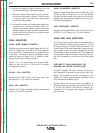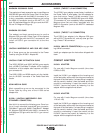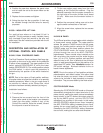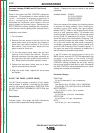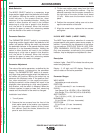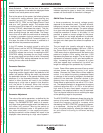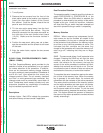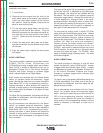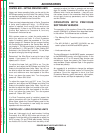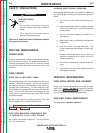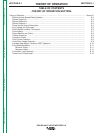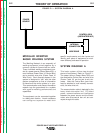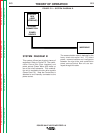
C-14
ACCESSORIES
C-14
Installation is as follows:
1. Turn off power.
2. Remove the two screws from the front of the
blank option panel at the location you choose to
install your new option (bottom) of the Control
Box cabinet. Save the screws, discard the old
panel or save for future use.
3. Tilt the new option panel away from the front
opening of the Control Box cabinet. Plug the
electrical connector into the proper connector on
the right side of the main printed circuit board
(10 pin). Make sure the connector latches in
place.
4. Position the new panel, taking care not to dam-
age the connections and the printed circuit board
on the back.
5. Align the screw holes, replace the two screws
and tighten.
K1542-11 MX2 Panel:
This panel provides a selection of four weld modes:
CV/MIG, CV/Flux Cored, CC/Stick/soft and
CC/Stick/Crisp through a toggle switch and indicator
lights (LEDs). It allows for adjustment of all set up
parameters, Preflow, Run In, Arc Control, Burnback,
Postflow, and Crater, through an up/down toggle
switch, indicator lights and a 3 digit display.
Weld modes are selected with the Mode Select
switch, an up/down center-off momentary toggle
switch. Moving the switch bat up or down moves the
Weld Mode LED in the corresponding direction.
Holding the switch in either direction will cause the
indicator to move quickly in the corresponding direc-
tion until the switch is released, or the upper or lower
limit is reached.
To adjust Set Up parameters, first select the Set Up
parameter for adjustment, and then adjust the dis-
played value up or down.
Set Up parameters are selected with the Select
switch, an up/down center-off momentary toggle
switch. Moving the switch bat up or down moves the
Weld Mode LED in the corresponding direction.
Holding the switch in either direction will cause the
indicator to move quickly in the corresponding direc-
tion until the switch is released, or the upper or lower
limit is reached.
POWER WAVE 455/POWER FEED 10
Return to Section TOC Return to Section TOC Return to Section TOC Return to Section TOC
Return to Master TOC Return to Master TOC Return to Master TOC Return to Master TOC
The value of the active Set Up parameter, as defined
by the Set Up LED, is displayed on the MX2 panel
Set Up display. The value can be modified with the
Set switch. The Set switch is an up/down center-off
momentary toggle switch. Moving the switch bat up
or down adjusts the displayed value in the corre-
sponding direction. Holding the switch in either direc-
tion will cause the display to move quickly in the cor-
responding direction until the switch is released, or
the upper or lower parameter limit is reached.
To energize the output studs in either CC/Stick
mode, the right Control/Display panel knob, labeled
Volts/Trim, must be used. The Volts/Trim knob must
be turned clockwise roughly a quarter revolution to
energize the output studs. (The Volts/trim display will
indicate ‘On’ when the studs are energized.)
Similarly, turning the knob a quarter turn counter-
clockwise de-energizes the output studs. If a
CC/Stick weld mode is entered through use of the
Dual Procedure, the studs will be in the same state
as when they were last used. If a CC/Stick weld
mode is entered through a Memory recall, the studs
will be de-energized.
K1542-12 MSP2 Panel:
This panel provides a selection of over 25 weld
modes, including CV, pulse, FCAW and CC, through
a toggle switch and indicator lights (LEDs). It allows
for adjustment of all set up parameters, Preflow, Run
In, Arc Control, Burnback, Postflow, and Crater,
through an up/down toggle switch, indicator lights
and a 3 digit display.
To adjust a set up parameter (Weld Mode being one
of those parameters), first select one of the set up
parameters for adjustment, and then adjust the dis-
played value up or down.
Set up parameters are selected with the Select
switch, an up/down center-off momentary toggle
switch. Moving the switch bat up or down moves an
LED in the corresponding direction. Holding the
switch in either direction will cause the indicator to
move quickly in the corresponding direction until the
switch is released, or the upper or lower limit is
reached.



